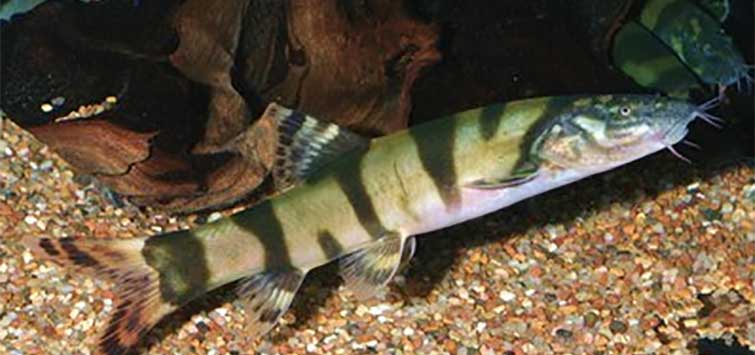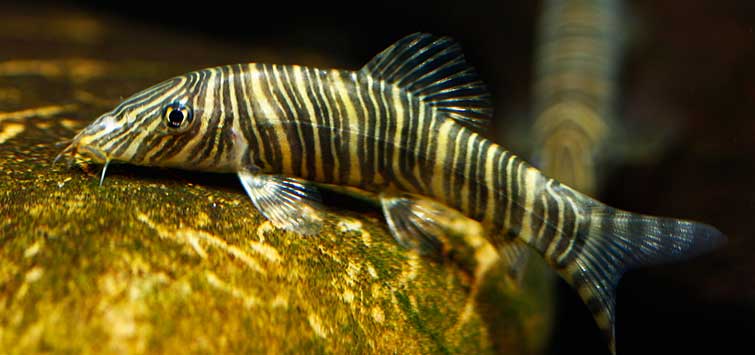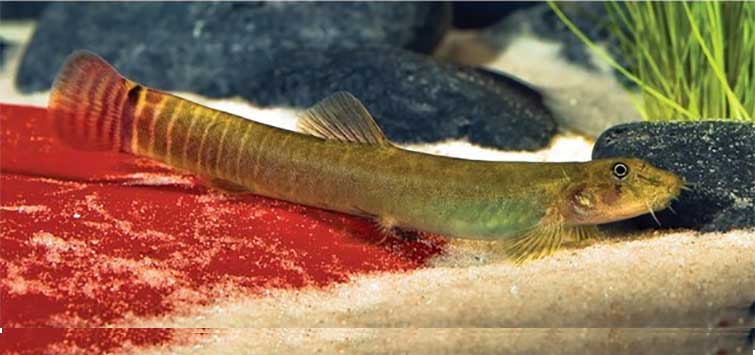The Imperial Flower Loach
Author: Wesley Wong and Stan Sung
Found in China's Yangtze River, the rare and incredibly beautiful imperial flower loach needs the aquarium hobby to come to its rescue.
The 11,000 Mile Journey
Our expedition took us over 10,000 miles by plane and 1000 miles by car. Countless emails, phone calls, and months of planning were undertaken before our physical search began—a journey that took Wes and me to a verdant hill country in the Sichuan Province. Delving deep into rural China, we hoped to find here the ultimate species of loach for the enthusiasts of the Cobitidae family.
The imperial flower loach Leptobotia elongata is unique among loaches for the spectacular yellow and black rosettes of the adult fish, as well as its behemoth size. I have seen photos of robust specimens over 30 inches long and weighing in at a massive 7 pounds! These characteristics put the imperial flower loach in a class of its own among the aquarium loaches.
History of the Imperial Flower Loach
Throughout the passage of time, flowing and meandering as many miles as there are years in dynasties past, is the mighty Yangtze River and its many tributaries. Up until five years ago L. elongata were frequently captured, and as many as 1000 pounds of these creatures could be taken a year.
Imperial flowers today are an extremely rare by-catch consisting of one or two specimens among hundreds of thousands of fish. The damming of the rivers has deprived L. elongata of their spawning migrations upriver and the impact of these dams on the wild populations has been severe. In some areas the local fishermen have not seen a single specimen in over two years.
A Glimmer of Hope: Aquarium-Industry Interest
In the mid-to-late 1990s, L. elongata were introduced to the aquarium world at Aquarama, a tropical fish show in Singapore. These first Leptobotia were marketed as royal clowns or simply royal loaches. I have selected to call them imperial flowers, as this is what locals in China have called them for centuries.
Legendary Asian species such as the redtail giant gourami Osphronemus laticlavius, Chinese high-fin shark Myxocyprinus asiaticus,and the imperial flower loach were all introduced at the same Aquarama show.
M. asiaticus
The Chinese high-fin shark M. asiaticus inhabits much of the same range in the Yangtze River as the imperial loaches. It is unfortunate that I have to report that both species have become dangerously imperiled and may become extinct in their native habitats very, very soon.
The high-fin shark has been saved, as it is an esteemed food fish in China. Juveniles have also become quite popular as sharp-looking fish for the home aquarium. Their popularity in both consumption and ornamental circles has been noted; this is one of the most widely aquacultured species in China, which has ensured its survival for commercial and reintroduction purposes.
L. elongata
L. elongata has, on the other hand, not fared so well. This is not an appreciated food fish in China, as the flesh is said to be mushy and falls apart when cooked. Traditionally, all the loaches found in China are cooked whole in a spicy broth. By no means, however, are these loaches a sought-after delicacy, and so there has been little interest for the aquaculture industry to work with this species. This, combined with the fish’s relative obscurity in the aquarium world, means that imperial flower loaches have become increasingly rare.
Up to five years ago some fish farms in China touted that they were raising these fish, yet many of these were simply wild-caught fish that were, at the time, commonly captured. These captured fish were placed into fish ponds and raised there until they were of market size (about 1½ years old).
Recently, our friend Mr. Yang in Sichuan Province has been successful for the first time in breeding these rarities via hormone injections. It is hoped that this article will bring attention and interest for the imperial flower loach. If this species becomes economically important, they will then be bred in larger numbers, allowing them to be reintroduced into their natural habitats.
The hydroelectric dam companies have been fined by the Chinese government and thankfully, some of the proceeds of these fines go toward the reintroduction of L. elongata. If the aquarium industry could find this unusual, colorful, and showy fish commercially viable, then specimens can be raised and sold at a larger profit for the Chinese fish farmers. In turn, hobbyists can help ensure the survival of these giant beauties by purchasing farm-bred and farm-raised fish.
Natural Ecology
L. elongata hail from the upper and middle Yangtze River and its tributaries. They inhabit clear-running streams and the littoral zone of deep, turbid rivers. The fishermen only capture this rare species upriver after the rains, when the water is turbid from runoff. If there is too much rain, these loaches cannot be found.
They prefer to live over gravel and smooth river-stone sediments. Their breeding season is from March to May, when they scatter their adhesive eggs in flowing waters. These eggs eventually make their way to areas with a gravel substratum where they develop, with the constant pull of the water currents to provide oxygen. The hydroelectric dams do not allow these fish to get to the flowing breeding sites that these loaches need to successfully mate and develop.
Biological examination of a wild-caught fish’s stomach contents showed them to consist of algae fibers, crustaceans, and mostly small, native catfish species. Temperatures in nature fluctuate seasonally from a low of 40°F to the mid-80s in the summer. A heater is not needed for proper maintenance of these loaches.
Husbandry Requirements
The first thing imperial flower loaches need is space, and lots of it. While enormous 7-pound specimens are few and far between, this is still a substantial fish that has high oxygen and generous food requirements. An aquarium of no less than 100 gallons should be used.
Shelter and Lighting
Like many loaches, this species tends to be somewhat shy in well-lit environments. In brightly lit tanks, uncomfortable specimens may huddle together, either in the corners of the enclosures or within submersed structures. It is cruel to keep loaches in aquariums with little in the way of shelter. For these rather serpentine fishes, either PVC tubes or a more natural-looking cave system should be designed for their use.
Community Life
When these loaches are initially introduced, they will crowd together as tightly as possible. After some time each fish may stake out and protect its own territory. This is a social species that should never be kept singly. Three specimens should be the minimum number kept in an aquarium.
Development
L. elongata grows quickly. With good care, imperial loaches can attain a size of 8 or 9 inches in a year. Eventually their growth slows down. As this species grows, their bodies become heavier and less serpentine in form. Large specimens well cared for are decidedly rotund, with an arched back and rounded abdomen.
Young specimens are a uniform, charcoal gray. At a size of a little more than 2 inches white bars begin to develop along their flanks. Gradually the bars become more distinct and the body becomes increasingly gold. The caudal fin also develops more reddish-orange colors as the fish grow. At a size of 8 inches, the bars begin to break apart and mature fish become marbled, especially on the head. The marvelous yellow and black rosettes on a fully grown imperial flower loach are truly spectacular.
Filtration and Aeration
Strong power filtration and aeration should be provided for these loaches. This is a hardy species that rarely succumbs to any of the standard aquarium diseases. It does have particularly sensitive skin that can become raw and infected, though, as abrasions are common on these bottom-grubbing fish.
Diet
Imperials do not behave aggressively in the home aquarium. They do, however, possess tremendous appetites and large mouths. Fish make up a major portion of their diet in nature, so tankmates should be chosen with care.
Any fish small enough to be consumed will be eaten. Young imperial flower loaches do well on live blackworms and frozen bloodworms, brine shrimp, mysis shrimp, and even sinking flake food. These are ambush predators that lie in wait until a prey item is within striking distance. The scent of food causes increased activity in captive subjects. These loaches will move their heads from side to side until their sensitive barbels detect a food morsel, which is quickly inhaled. Large L. elongata need bigger, meatier foods such as chopped market shrimp, smelt, night crawlers, and whole krill. Feeding these fish a diet rich in carotenoids will keep up their yellow and red colorations.
Final Thoughts
At the time of this writing Leptobotia elongata has still not been evaluated on the IUCN Red List. Wesley and I were granted special permission from the local government to obtain this species, and we were given special permits to try to collect specimens. In return, our donations were used for research and reintroduction of this fish into their wild habitat. We were able to procure a handful of large and small captive-bred imperial flower loaches, and a total of five wild specimens were encountered during our explorations of Sichuan Province.
See the full article on TFH Digital http://www.tfhdigital.com/tfh/201005/#pg67

.png?h=595&iar=0&w=2781&hash=5FD5E69473BCC22199FBFA2FB71B6033)



